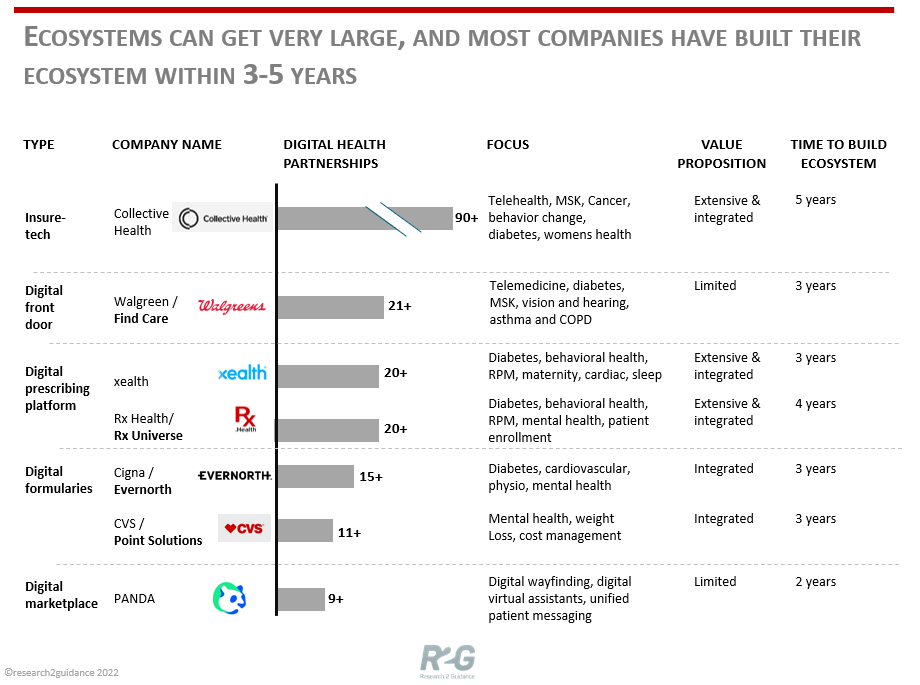Linkedin
Research2Guidance
Accessed on May 30, 2022
In the last 3–5 years there has been a rapid expansion of ecosystems consisting of digital health applications.
Health insurance companies or insure-techs sometimes include up to 100 solutions from third-party providers in a wide variety of digital health segments.
Ecosystem providers should now concentrate on improving their value proposition in order to be successful.
Digital health ecosystems have rapidly grown also in response to the COVID -19 pandemic.
There are now hundreds of digital health ecosystems around the world. Consumers nowadays demand a connected health experience, while health systems want digital solutions to be integrated into the electronic health records and clinicians prefer solutions that fit into their workflow. Ecosystems offer one stop solutions for consumers and patients.
Digital health formularies and marketplaces make it easier for health systems to choose from a list for curated and vetted solutions that have proven to result in clinical and economic benefits.
Employers can integrate 3rd party digital health solutions into their self-funded healthcare plans without having to negotiate a contract with each and every 3rd party digital health solution provider. It has been all done already.

There are five main categories of digital health ecosystems that differ in size, business model, focus areas and value proposition.
- Digital health marketplaces
- Digital health prescribing platforms
- Digital health formularies
- Digital front door
- Insure-tech
Digital health marketplaces:
Digital health solutions marketplaces main aim is to connect vendors of digital health and buyers of these solutions.
Buyers benefit from pre-selected best-in class solutions while vendors are promoted to all buyers in the marketplace.
In addition to providing a curated list of solutions for buyers to procure, companies like PANDA offer other services such as end-to-end contacting services, cyber security review.
All these services are geared towards decreasing procurement time/effort and speeding up implementation time. Marketplace ecosystems vary in size, depending on the partner selection criteria.
PANDA currently has 9 vendors listed, offering digital wayfinding and patient messaging and plans to add other segments in the future, including telehealth and customer relationship management.
Digital health prescribing platforms:
Platforms like Xealth and Rx Health were created out of collaboration with hospital systems, and it is not surprising that these platforms are focused on EHR integration, showing high integration levels and addressing the needs of physicians for prescribing DTx solutions directly from the patients’ medical record.
The other advantage is that the hospital system and 3rd party solutions all integrate with these platforms, so the connection does not need to be built each time the health system decides to add a new digital health solution, saving time and resources.
Digital health formularies:
Ecosystems such as CVS point solutions and Cigna Evernorth mainly focus on chronic conditions and mental health.
These ecosystems are usually medium in size, due to stringent conditions of the partner selection process and the time it takes to vet and select best-in class partners.
Starting in June 2019 with a single behavioral health solution Sleepio, CVS has managed to expand to over 11+ solutions within 3 years.
Digital front door:
Digital front door ecosystems aim to make it easier for patients to get access to the right care.
A prime example is Walgreens Find Care® platform.
Since the focus is on access, the integration level is generally low for these systems.
Digital partner solutions are focused on chronic conditions such as diabetes, asthma and COPD and telehealth services are important cornerstones of these ecosystems.
These systems are the most rapidly growing, with Walgreens Find Care® adding 11 new partners to their ecosystem just last year, bringing the number of partners to over 20.
Insure-tech:
Companies such as Collective Health were born out of the mission to simplify employee care.
Geared towards self-funded employers, these ecosystems tend to have a large number of partners and high level of integration, allowing for data sharing, managing the billing and accounting as well as member communications.
They bring together 3rd party solutions into one connected system which includes financial management and payments, program optimization, performance monitoring and patient engagement tools.
Such ecosystems also make it easier for employers to select, integrate, and evaluate digital health partners.
The open architecture of the Collective Health platform also allows employers to connect in their choice of solutions.
The core digital solutions focus on telehealth, MSK, cancer, behavior change, diabetes, and women’s health and include Teladoc, Hinge Health, Lyra and Ginger.
Typically digital health ecosystems are built in waves, meaning that a company starts with 3–5 3rd party digital health solutions e.g. for patients with diabetes, mental health or sleep problems and activity tracking solutions and a telehealth solution and then expands into other segments of the digital health market. Building a large ecosystem of 50 solutions within three years has proven to be feasible.
Today’s digital health ecosystems all provide some sort of curated selection of digital health solutions.
High integration levels are a requirement for success and ecosystems clearly must go beyond simple lists of digital solutions and we will likely see a rise in highly integrated platforms like xealth, allowing prescribing and monitoring of digital health solutions directly from the EHR.
Building digital health ecosystems is a 3–5 year project that requires not only an efficient partner screening and selection process but also the creation of a competitive value proposition, a clear roadmap, a team that is embedded in a sustainable governance structure and a monitoring that allows constant learnings and implementation changes.
Building digital health ecosystems is a 3–5 year project that requires not only an efficient partner screening and selection process …
… but also the creation of a competitive value proposition, a clear roadmap, a team that is embedded in a sustainable governance structure and a monitoring that allows constant learnings and implementation changes.
Originally published at https://www.linkedin.com.












